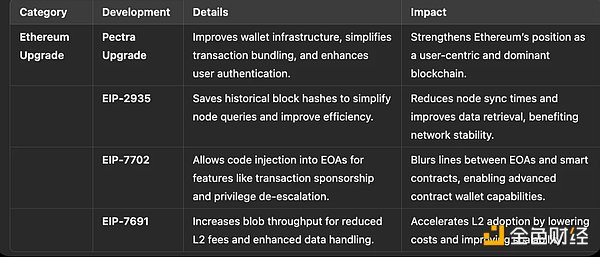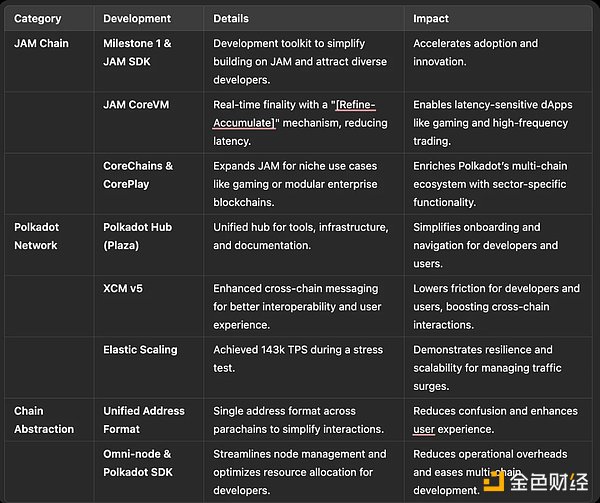Author: arndxt Source: X, @arndxt_xo Translation: Shan Ouba, Golden Finance
As 2024 ends and 2025 arrives, I look back on my crypto journey and draw inspiration from discussions at OpenGuild Vietnam, conversations around Ethereum, and Optimism Superchain. The following is an in-depth analysis of the key technical and strategic developments that are shaping the future of Polkadot and Ethereum.
Crypto Market Overview
Overall, the market is at a critical node of regulatory and technological change, especially in Vietnam and at the intersection of AI and crypto.
1. Legalization of Crypto in Vietnam
The Vietnamese government plans to complete the development of a legal framework for cryptocurrencies by May 2024, which could herald the rise of a wave of legal crypto businesses.
• Regulatory clarity can reduce uncertainty and attract higher-quality projects and institutional investment interest.
• If structured properly, Vietnam could become a hub for blockchain startups, connecting Southeast Asia’s vibrant tech ecosystem to the global crypto market.
2. Stablecoins and User Adoption
The use of stablecoins has grown significantly, and this trend is expected to continue. Enhanced stablecoin infrastructure could drive wider adoption, especially in regions where local currencies are volatile.
Stablecoins are one of the most powerful entry applications in the crypto space. By providing a secure medium of exchange, stablecoins can facilitate everyday transactions and protect value during local currency fluctuations. Continued improvements, such as more efficient on- and off-ramps for funds, could further embed stablecoins into the global financial system.
3. AI Agent Ecosystem
Since late 2024, the rise of AI and crypto solutions has attracted increasing attention from investors and incubators such as Y Combinator. AI agent ecosystems (e.g., fully autonomous trading bots, decentralized AI modules, on-chain AI oracles) are expected to simplify tasks that traditionally require human intervention. As these systems mature, they may raise complex legal and technical questions about governance, liability, and data privacy.
4. Proof of Personhood
The convergence of AI and crypto naturally raises concerns about identity verification, especially with the proliferation of deep fakes and AI-generated personas. Proof of identity is based on decentralized identity solutions and aims to ensure unique human authentication.
If AI can simulate human behavior on-chain, strong identity mechanisms will become particularly important. Proof of identity may become the standard for social applications, DAO membership, or token airdrops. Further innovations in cryptographic methods such as zero-knowledge proofs are expected to maintain privacy while verifying authenticity.
Ethereum Ecosystem
In 2025, the evolution of Ethereum focuses on chain abstraction and protocol-level upgrades that aim to improve network efficiency, L2 throughput, and user experience.

1. Pectra Upgrade
The Pectra upgrade is a major milestone for Ethereum, focusing on improving wallet infrastructure and addressing broader challenges in the ecosystem. As chain abstraction becomes a core priority for various blockchain platforms, the success of Pectra may redefine how users interact with Ethereum.
The Pectra upgrade on Ethereum is a key milestone, focusing on improvements to wallet infrastructure and addressing broader ecosystem challenges. As chain abstraction becomes a key priority for blockchain platforms, Pectra’s success could redefine how users interact with Ethereum.
From my perspective, Ethereum’s mainnet is at a crossroads. The rise of powerful L2s like Optimism, Arbitrum, and zkSync has increased the pressure to maintain Ethereum’s “gold standard” status. Pectra has the potential to fill a critical gap — simplifying the wallet experience by addressing pain points like high gas fees, transaction bundling, and user identity verification. If implemented effectively, it could significantly enhance user onboarding while solidifying Ethereum’s dominance in an increasingly competitive ecosystem. To me, this is Ethereum doubling down on user-centric innovation, a move that could secure its place in the blockchain hierarchy.
2. EIPs to watch in 2025
• EIP-2935: Store historical block hashes in state
• Functionality: Storing block hashes over a period of time simplifies the node query process, improves efficiency and reduces overhead.
• Analysis: This is a "network foundation" improvement that is not very noticeable but is critical for node operators. The improved data retrieval mechanism can also reduce chain reorganization and node synchronization time.
• EIP-7702: Set single transaction code for EOA accounts
• Functionality: Inject code for externally owned accounts (EOA) through special transaction types, supporting features such as transaction bundling, paying gas fees (sponsorship), and permission downgrade (without changing addresses).
• Analysis: The proposal blurs the line between EOA and smart contracts, and may promote more complex contract wallets (such as ERC-4337-based solutions). If widely adopted, it may give rise to more user-friendly features such as transaction sponsorship or advanced multi-signature schemes.
• EIP-7691: Increase Blob Throughput
• Functionality: Building on improvements in EIP-4844 (Proto-Danksharding), increase the number of blobs per block, further reducing L2 fees and enhancing throughput.
• Analysis: The coordinated expansion of L1 and L2 is critical to Ethereum. By expanding blob capacity, Ethereum reaffirms its commitment to maintaining a low-cost L2 environment. This improvement may accelerate user adoption of L2 solutions.
Polkadot Ecosystem
Polkadot continues to be a hotbed of cross-chain experimentation in 2025, with multiple developments aimed at solidifying its position as a high-throughput and interoperable decentralized application infrastructure.

1.JAM Chain and its innovation
JAM Chain is a next-generation blockchain protocol that has attracted widespread attention in the Polkadot ecosystem. If successful, JAM can demonstrate Polkadot's commitment to a plug-and-play multi-chain architecture.
Milestone 1 and JAM SDK An important milestone for the JAM team is the completion of [JAM Milestone 1], which includes the launch of a development toolkit called JAM SDK. This SDK should make building on JAM easier, potentially appealing to a wider range of developer types (from traditional backend engineers to professional blockchain developers).
JAM CoreVM The introduction of JAM CoreVM could redefine how real-time transactions and application execution are handled. By replacing the traditional block finalization method with an "[optimize-cumulative]" mechanism, JAM CoreVM aims to provide near-real-time finality. This approach can significantly reduce latency, which has been a long-standing challenge for blockchains to achieve fast confirmations without sacrificing security. If executed effectively, it could encourage more latency-sensitive dApps (such as high-frequency trading, real-time games, or event-driven DeFi) to migrate to or launch Polkadot parachains powered by JAM.
CoreChains, CorePlayAfter completing the virtual machine layer, the JAM team plans to expand functionality through CoreChains and CorePlay. While further details are limited, these solutions appear to extend JAM’s architecture, potentially targeting niche use cases such as gaming ecosystems or enterprise-grade blockchains where modular design is critical. The philosophy of Polkadot revolves around specialized parachains. JAM’s approach to building CoreChains suggests a possible shift toward industry-specific functionality. If these specialized chains each address unique challenges (such as compliance, gaming, or data management), it could enrich Polkadot’s value proposition as a multi-chain network.
2. Polkadot Network-Wide Improvements
In addition to JAM’s initiatives, Polkadot itself will also undergo significant upgrades to reflect lessons learned from network stress testing and community feedback over the past year.
The completion of the Polkadot Hub (Plaza) is dedicated to consolidating ecosystem tooling, infrastructure, and documentation. Analysis: As the ecosystem expands, a unified hub makes sense for both new and experienced developers. Centralizing resources can significantly reduce complexity, which is an important step in attracting more developers and end users in the fierce competition with other L1 and L2.
XCM v5 Cross-chain Messaging (XCM) is key to Polkadot's interoperability vision. The arrival of XCM v5 is expected to enable more powerful cross-chain communication and better user experience. Analysis: Cross-chain operability remains the holy grail in the cryptocurrency space. While existing solutions such as Wormhole and LayerZero help connect the ecosystem, XCM is a dedicated tool for Polkadot. Making XCM more efficient and secure can make inter-parachain operations feel "native", potentially reducing friction for users and developers.
Elastic Scaling After a severe spam attack on Kusama in December 2024, Polkadot's elastic scaling mechanism demonstrated the ability to reach 143k TPS. This achievement highlights Polkadot's resilience under high load. Analysis: The chain's ability to handle sudden traffic spikes is critical. Successfully responding to spam attacks can be a marketing boon, demonstrating resilience and reliability. However, the real test lies in managing legitimate traffic surges - especially if Polkadot-based dApps gain mainstream popularity.
3. Chain abstraction and full network development
Polkadot's overall strategy increasingly revolves around making the network more accessible to developers and users, ensuring that the underlying complexity remains behind the scenes.
Unified address format By providing a single address format across parachains, Polkadot aims to eliminate the confusion caused by multiple wallet standards. Simplifying addresses is not easy, but it is a foolproof way to reduce the friction of cross-chain interactions. This is reminiscent of how large ecosystems (such as Apple's iOS) unify the user experience of multiple apps and services.
Omni-node and Polkadot SDKMaintaining up-to-date node software for dozens of parachains requires significant resources. Omni-node aims to simplify this process by optimizing resource allocation. From a developer perspective, less operational overhead is always welcome. However, the complexity of Polkadot’s multi-chain approach will likely require ongoing improvements in developer tooling, and thus iterative enhancements beyond Omni-node.
Final Thoughts
Meanwhile, broader market trends, including regulatory moves in Vietnam, enhancements to stablecoins, and AI-driven proxy systems, highlight the rapid pace of development in the crypto space.
Ethereum continues to iterate with the Pectra upgrade and new EIPs, solidifying its L1 position as a trusted settlement layer for a thriving L2 ecosystem.
On Polkadot, innovations such as JAM Chain, Omni-node, and improved XCM are designed to improve cross-chain usage and expansion.
 Miyuki
Miyuki
 Miyuki
Miyuki Kikyo
Kikyo Weatherly
Weatherly Catherine
Catherine Anais
Anais Kikyo
Kikyo Anais
Anais Catherine
Catherine Joy
Joy Weatherly
Weatherly